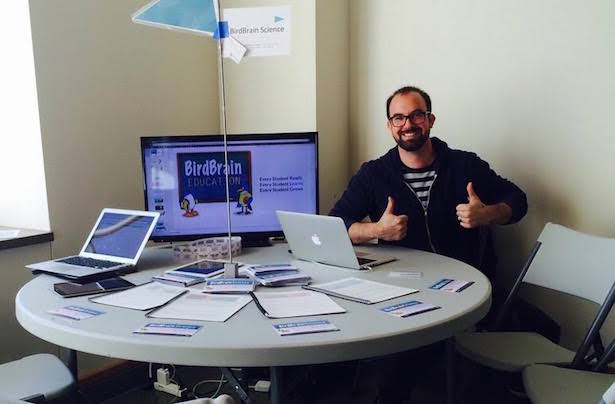How hard times in LA schools sparked a ‘teacherpreneur’ to create BirdBrain Science
Mark Keierleber | February 26, 2016
Your donation will help us produce journalism like this. Please give today.

Brendan Finch (courtesy photo)
It was a devastating time for the young teachers who worked at John H. Liechty Middle School near downtown Los Angeles. It was 2009, and 72 percent of the school’s teachers were handed pink slips, casualties of America’s crumbling economy.
Brendan Finch, working there through Teach For America, was among those let go, though he did return for a second year as a permanent substitute in the same classroom. It was the experience of working in a cash-strapped school that led Finch to launch BirdBrain Science, an adaptive online education platform that produces science articles that match students’ independent reading levels. In December, the Los Angeles-based company launched a second platform: BirdBrain History.
“The rationale here is that in any subject area, science for example, concepts and ideas that are being taught are the same across the class. The thing that changes is the student’s ability to comprehend advanced language,” Finch said. “All articles contain the same essential concepts, just at different reading levels.”
During his year-long assignment as a permanent substitute, Finch taught math and science while his partner teacher covered English and history. Two weeks into the school year, however, the partner took maternity leave and never came back. Over the course of the year, Finch said 11 new teachers filled the role, “as these kids became further disillusioned every single month.”
“We’d been watching Bill Nye and acting out the process of photosynthesis, I had alternative assessments out the wazoo, my kids knew their science,” he said. “But they failed their standardized tests because they couldn’t read and they couldn’t explain what they knew in writing.”
So the “teacherpreneur,” who is now 31, recruited “Jedi master” web developer Grenard Madrigal, a friend from their time as students at the University of California, Santa Barbara, and created BirdBrain Science.
Here’s how it works: When students log onto the platform, they take a quiz to diagnose their reading level. When a teacher selects a classroom topic, each student is given the same science article — though the language in the text is adjusted to coincide with each student’s reading ability.
Geared toward mid-elementary and middle school science standards, BirdBrain currently offers seven different reading levels beginning with third grade through high school.
At the end of the article, students take another quiz, which is aligned with the Common Core State Standards to gauge understanding and to adjust the reading level for the next assignment. Teachers can then see a dashboard of data about students’ comprehension of vocabulary words and reading growth.
At first BirdBrain was a side project while Finch worked at several Los Angeles charter schools. He quickly realized he’d have to quit his day job. Following beta testing in 2013, more than 100,000 students and teachers now use BirdBrain Science. So far, the BirdBrain team has written more than 200 science articles.
Backed by a grant from NewSchools Venture Fund, a nonprofit education reform philanthropy, the group has accumulated about 60 articles for its history platform on topics ranging from ancient China to the American Revolution.
“If we can get students that are behind in reading, to read independently in both ELA and also science and social studies, there will be no achievement gap,” he said. “Those students will have such high confidence by the time they reach high school that they won’t be five grade levels behind, and they’ll have been reading successfully for years before that.”
This idea isn’t new — all kinds of companies are dishing up education material based on students’ reading levels. But BirdBrain Science costs teachers $4 per student per year, well below the competition. A similar company, Books that Grow, for example, costs $9 per month.
For the rest of the school year, teachers and students can access BirdBrain History for free.
Although they have assembled a small team, BirdBrain doesn’t have an office. Too much overhead. Finch wants his product to stay affordable, a hat tip to his time working in the classroom.
“Our goal is to create sort of an adoptive curriculum that’s highly financially accessible, that teachers can purchase with their classroom budgets, and districts don’t have to get a grant to pay for,” Finch said. “Now with the proliferation of ed-tech tools, a teacher should be able to choose several of us. Everybody should be able to throw their secret teacher sauce on the different lessons and serve it to their students as the tastiest knowledge that they’ve ever had.”
This article was published in partnership with The74Million.org.